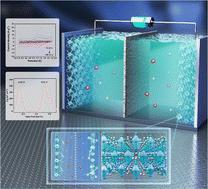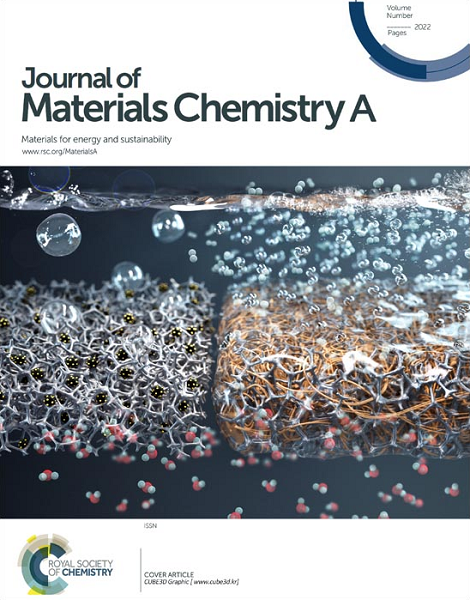Non-porous two-dimensional conducting metal–organic frameworks with enhanced capacitance
IF 10.7
2区 材料科学
Q1 CHEMISTRY, PHYSICAL
引用次数: 0
Abstract
The specific performance of two-dimensional conductive metal–organic frameworks (MOFs) in energy storage devices is significantly constrained by the presence of bulky redox-active centers and densely packed interlayers. Herein, we report two semi-conductive MOFs, Fe-MOF and Cr-MOF, using a small aromatic linker, pyrazine (pyz). Both MOFs demonstrated exceptional capacitive properties in an ionic electrolyte. Despite having similar layered AB-stacking geometries and non-porous structures, the single-crystalline Fe-MOF demonstrated weaker redox interactions between Fe2+ and pyz nodes, resulting in typical semiconducting properties with a bandgap of ∼1.07 eV. In contrast, the Cr-MOF exhibited a high conductivity, reaching 9.0 mS cm−1 at 350 K. Remarkably, the Fe-MOF electrode delivered a specific capacitance of 436.7 F g−1 at 0.5 A g−1, almost three times higher than that of the Cr-MOF (123.5 F g−1), despite its larger bandgap. Moreover, a high energy density of 98.2 W h kg−1 and excellent cycling stability (retaining 95.3% after 10 000 cycles) have been achieved in the Fe-MOF electrode. In situ experimental analysis together with theoretical calculations revealed that the superior charge storage capability of the Fe-MOF originated from the participation of both cations and anions in the diffusion-controlled charge storage, even with a non-porous structure. This study enhances our understanding of energy storage mechanisms in non-porous conductive MOFs and provides valuable insights for the development of advanced MOF materials for future energy storage applications.

具有增强电容的无孔二维导电金属有机框架
二维导电金属有机框架(MOFs)在储能设备中的具体性能受到笨重的氧化还原活性中心和密集夹层的严重制约。在此,我们报告了两种半导电 MOF:Fe-MOF 和 Cr-MOF,它们都使用了小型芳香族连接物吡嗪(pyz)。这两种 MOF 在离子电解质中都表现出优异的电容特性。尽管具有相似的层状 AB 堆积几何结构和无孔结构,但单晶铁-MOF 在 Fe2+ 和吡嗪节点之间的氧化还原作用较弱,因此具有典型的半导体特性,带隙为 1.07 eV。相比之下,Cr-MOF 表现出很高的电导率,在 350 K 时达到 9.0 mS cm-1。值得注意的是,在 0.5 A g-1 的条件下,铁-MOF 电极的比电容为 436.7 F g-1,几乎是铬-MOF(123.5 F g-1)的三倍,尽管其带隙更大。此外,Fe-MOF 电极还实现了 98.2 W h kg-1 的高能量密度和出色的循环稳定性(10,000 次循环后保持 95.3%)。现场实验分析和理论计算显示,Fe-MOF 优异的电荷存储能力源于阳离子和阴离子都参与了扩散控制的电荷存储,即使是无孔结构也是如此。这项研究加深了我们对无孔导电 MOF 储能机理的理解,为未来储能应用领域先进 MOF 材料的开发提供了宝贵的启示。
本文章由计算机程序翻译,如有差异,请以英文原文为准。
求助全文
约1分钟内获得全文
求助全文
来源期刊

Journal of Materials Chemistry A
CHEMISTRY, PHYSICAL-ENERGY & FUELS
CiteScore
19.50
自引率
5.00%
发文量
1892
审稿时长
1.5 months
期刊介绍:
The Journal of Materials Chemistry A, B & C covers a wide range of high-quality studies in the field of materials chemistry, with each section focusing on specific applications of the materials studied. Journal of Materials Chemistry A emphasizes applications in energy and sustainability, including topics such as artificial photosynthesis, batteries, and fuel cells. Journal of Materials Chemistry B focuses on applications in biology and medicine, while Journal of Materials Chemistry C covers applications in optical, magnetic, and electronic devices. Example topic areas within the scope of Journal of Materials Chemistry A include catalysis, green/sustainable materials, sensors, and water treatment, among others.
 求助内容:
求助内容: 应助结果提醒方式:
应助结果提醒方式:


